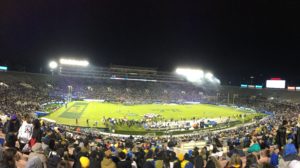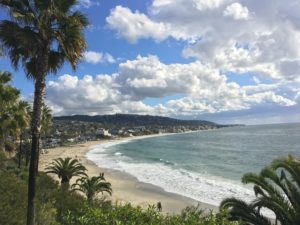With the support of NORBIS, I visited Professor Bernhard Palsson’s group, Systems Biology Research Group, in University of California, San Diego, USA, from September 2019 to February 2020.
The original plan was actually from May to November 2020, but my application of the US visa was pending in the so-called “administrative process” for four months. But this delay took me to UCSD right at the beginning of the new semester. There are good and bad of that: good thing is that there were lots of welcoming activities on campus; bad thing is that accommodation is in short, especially the flights and (temporary) accommodation were almost booked at the last minute because I couldn’t make any travelling plan before I got the Visa, and the long-term accommodation was booked after I arrived there when most of the resources had already been reserved by the freshmen. So advice from me will be: plan ahead and start the paperwork early.
Bear at Jacobs School of Engineering, UCSD. Photo: Xiaokang Zhang
The campus of UCSD is in La Jolla, 20 minutes’ drive to the north of San Diego downtown. Everything in La Jolla is far away from each other. Even though it’s a good opportunity for walking since it’s very sunny almost the whole time (and for Bergen, it’s rainy or cloudy almost the whole time 😉 but walking from my apartment to the campus is 40 minutes, and another 40 minutes to the nearest supermarket. Public transportation is sort of useless. But that’s a common problem for the people who don’t have a car, so carpooling is very popular. So that problem can be naturally solved after you make enough friends.
My main job there is to continue our collaboration which already started one year before I went there. Carrying particular questions in mind, my work started immediately after I arrived. The first problem solved was visualization of our draft reconstruction model. With the help of Zachary A. King, the main developer of Escher (https://escher.github.io/#/), and the others in the Escher group, our ugly and messy metabolic map was replaced with an elegant and informative Escher map. From there, I worked closely with Daniel Zielinski to explore the draft model. Our work was later presented in the conference Winter Q-Bio 2020 (https://w-qbio.org/), and will also be included in the manuscript currently in preparation from dCod project (https://www.uib.no/en/dcod).
Besides the project mentioned above, a paper from our previous work (An Ensemble Feature Selection Framework Integrating Stability, DOI: https://doi.org/10.1109/BIBM47256.2019.8983310) was accepted as conference proceedings paper in BIBM 2019 which happened to take place in San Diego two months after I went there. Another manuscript was also finished and submitted to BMC Bioinformatics during my stay there, and it was accepted just before I came back to Bergen (RASflow: an RNA-Seq analysis workflow with Snakemake, DOI: https://doi.org/10.1186/s12859-020-3433-x).
NCAA football match UCLA vs. CAL. Photo: Xiaokang Zhang
By attending the group meeting every two weeks and the group’s winter retreat day, I got to learn the many interesting research topics going on in the group and was also shocked by the large publication number shown in the annual summary on the group retreat day.
Overall, it was an excellent research visit with lots of research input and output, and also lots of cool friends, good food, beautiful beaches, sunshine.
Laguna Beach. Photo Xiaokang Zhang


